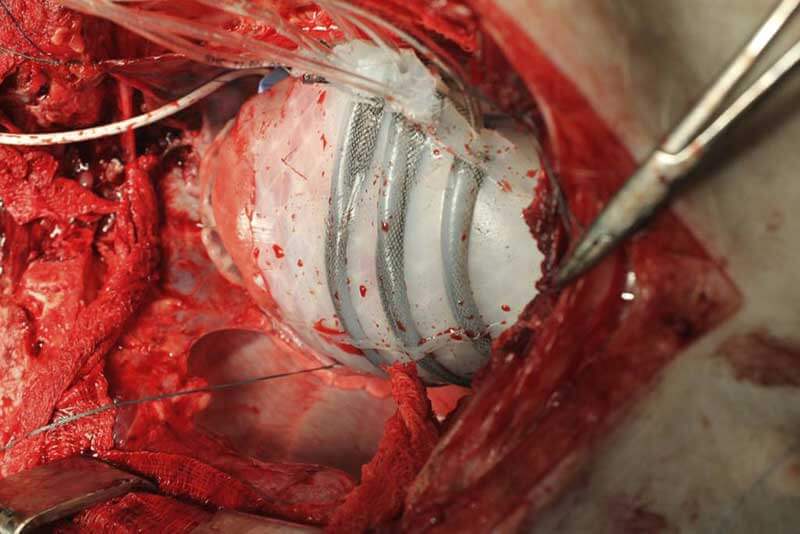- Squishy, invisible robot claw catches fish as they swim by
- Stanford’s pneumatic snake robot may soon save lives
- Ocado’s tentacled fruit picker can grasp soft and fragile objects
- A robotic heart pump squeezes life back into patients
When you think about robots, you probably imagine cold machines made of hard plastics and rigid steel, with sharp edges and powerful servos. In your mind, these machines are probably on an assembly line, welding car parts in a shower of sparks or packing items for shipping. Perhaps, if you’ve followed robotics closely, you also think of worker-friendly cobots – careful mechanical arms that sense human presence and slow down to avoid injuring the people around them as they work to pick and sort small items for shipping.
But the latest generation of robots is no longer big and bulky with hard, rigid edges. They’re soft and somewhat creepy, moving with rhythms that mimic snakes, caterpillars, vines, and squid. It’s certainly not how we would imagine them, and their unsettling movement is, well, unsettling. But they were designed as innovative solutions to problems that conventional robots just can’t solve. And these cutting-edge soft robots give us a glimpse of the future of automation.
For some problems, robotics has reached its limit. For instance, automation often requires interaction with fragile things. Robots need to grasp melons, or turn and move a patient’s liver during surgery. Maybe they have to move fish from one tank to another, pick delicate fruit, or provide direct heart stimulation. In any of these cases, conventional robotics just won’t do. A robotic claw made from ceramics and steel, even if you limit its strength, is likely to kill the fish, mash the fruit, or damage the heart. What you need is something soft, something that can grab and grip without endangering what it holds.
Squishy, invisible robot claw catches fish as they swim by
Scientists at MIT have been working on soft robotics for a while, and as they’ve learned more, they’ve set new, more difficult goals for their research. Their latest goal was to be able to catch a swimming fish without injuring it. The problem was that the materials traditionally used for robots, even clear silicone, were either a danger to the animal or too easily detected by it. Fish don’t want to be caught, after all! Even the most transparent plastics and gels aren’t invisible to the fish’s delicate senses. Their solution was a special hydrogel, a substance that’s almost 80 per cent water by weight. It’s usually too soft for this kind of application, so they developed a new formula that’s hardened by UV light, allowing it to remain soft and pliable, while providing it the necessary strength. And best of all – because it’s mostly water – the fish can’t sense it.
The result was a nearly invisible hydraulic claw that can capture a swimming goldfish and release it unharmed. This research has taught the scientists at MIT new ways of moving and controlling their invisible, squishy hand. They’re now able to move their soft robot with much greater speed than conventional approaches allow, paving the way for future advances.

Stanford’s pneumatic snake robot may soon save lives
But even weirder robots are being tested by scientists at Stanford. Imagine an inverted tube of clear plastic, like a garden hose pulled inside out. As the plastic is filled with compressed air, it grows, stretching outward like a living thing into long, curled, snake-like lengths. The team, led by Elliot Hawkes, is exploring what this simple robot can do – and they’re constantly being surprised. Because it’s soft, and because it ‘grows’ with compressed air, it can find tiny cracks and slip through them, inflating to lift heavy objects. As Joey David Greer, one of the team members, explains, “One thing we found with this growing robot, is that it is surprisingly difficult to stop it from lengthening when it is pressurized — if there is a way it can extend, it probably will.” They conducted tests in which it wormed its way under a 100 kg box, lifting it from the ground once enough of the robot’s snake-like body had worked its way under it. The researchers hope to develop this robot further, with its most promising application being search and rescue. Just imagine how many lives will be saved when this robot becomes viable tech.
Ocado’s tentacled fruit picker can grasp soft and fragile objects
Watching these soft robots in action is more than a bit creepy. Ocado’s fruit picker, for instance, is enough to fuel nightmares. Its quivering grabber reaches for the fruit below it, slowly dropping onto an unsuspecting bag of limes. It then wraps its tentacles around the tiny bag of green fruit, ensnaring it in tendrils that jiggle like hardened Jell-O. If you were directing a horror movie with produce as the main protagonist, this would be the villain! Ocado is an online retailer that offers soft, easily damaged items as part of its stock. As Alex Harvey, the company’s head of robotics and autonomous systems, told Wired, “There are 48,000 different items we have in the warehouse and the diversity, size, shape, and rigidity of all these items makes it a very difficult robotics problem from a manipulation perspective.” Old-school robotics aren’t up to the task, and they’ve settled on the Soma robotic arm as a solution. Its soft grip can grasp pretty much anything fragile that needs to be picked and packed.
A robotic heart pump that squeezes life back into patients
This grasping action hasn’t been missed by physicians, either. They’re exploring how it can help heart patients in recovery. We already have mechanical heart pumps that assist people who’ve suffered heart attacks, but these machines require direct contact with the patient’s blood and the risk of clots means heavy doses of dangerous blood thinners for the patient. A new design from Harvard’s School of Engineering and Applied Sciences uses an air pump to power a soft robotic hand that gently squeezes the heart, helping it pump life-giving blood. It’s attached to the heart with gel, suction, and sutures, and it’s customised to match what the patient needs – more pressure on this or that side, a harder squeeze here or there, etc. While it’s still being tested, and is intended as a temporary ‘bridge’ measure until the heart recovers, Frank Pigula, a physician and researcher of this new tech, says that “One day the robotic sleeve may help their heart work well enough that their quality of life can be restored.”
These soft robots are still in the early stages of research and design, and each of them requires an external pump to provide the fluid or air that drives their motion. But they’re teaching researchers a lot about how this new generation of robots might help us, from pneumatic rescue snakes that can squiggle through cracks and lift debris, to robotic heart gloves that squeeze life back into us, one pump at a time. The future of machines may be hard science, but it looks like it might be soft robots as well.

Share via:


